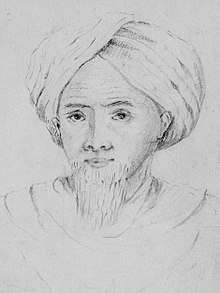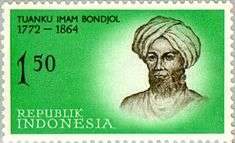Tuanku Imam Bonjol
Tuanku Imam Bonjol (1772 – 6 November 1864), also known as Muhammad Syahab, Peto Syarif, and Malim Basa, was one of the most popular leaders of the Padri movement in Central Sumatra. He was declared a National Hero of Indonesia.[1]
Tuanku Imam Bonjol | |
|---|---|
 Tuanku Imam Bonjol | |
| Born | 1772 |
| Died | 6 November 1864 (aged 92) |
| Nationality | Pagaruyung |
| Other names | Muhammad Syahab Peto Syarif Malim Basa |
| Known for | Padri War |
Biography
%2C_processed%2C_obverse_and_reverse.jpg)

Tuanku Imam Bonjol was born in Bonjol, Pasaman, West Sumatra. His family came from Sungai Rimbang, Suliki, Limapuluh Koto.[2] His parents name were Bayanuddin (father) and Hamatun (mother). He was immersed in Islamic studies as he grew up, studying first from his father and later under various other Muslim theologians.
After founding the state of Bonjol, Syarif became involved in the Adat-Paderi controversy as a Paderi leader. The Paderi movement, which has been compared to the Ahlus Sunnah wal Jamaah (Sunni) school of Islam in the now Saudi Arabia, was an effort to return the Islam of the area to the purity of its roots by removing local distortions like gambling, cockfighting, the use of opium and strong drink, tobacco, and so forth. It also opposed the powerful role of women in the matrilineal Minangkabau culture. The Adat, or traditionalist, position was that local custom that pre-dated the arrival of Islam should also be respected and followed.
Feeling their leadership position threatened, the traditionalists appealed to the Dutch for help in their struggle against the Paderis. At first, the Dutch were not able to win militarily against the Paderis because their resources were stretched thin by the Diponegoro resistance in Java. In 1824, the Dutch signed the Masang Agreement ending hostilities with the state of Bonjol.
Subsequently, however, once the Diponegoro resistance was suppressed, the Dutch attacked the state of Pandai Sikat in a renewed effort to gain control of West Sumatra. Despite valiant fighting by the Indonesians (by this time the traditionalists had realised they didn't want to be ruled by the Dutch either and had joined forces with the Paderis in their resistance), the overwhelming power of the Dutch military eventually prevailed. Syarif was captured in 1832 but escaped after three months to continue the struggle from his tiny fortress in Bonjol.
After three years of siege, the Dutch finally managed to sack Bonjol on 16 August 1837. Through a negotiation ruse, the Dutch again captured Syarif and exiled him, first to Cianjur in West Java, then to Ambon, and later to Manado in Sulawesi. He died on 6 November 1864, at the age of 92 and is buried in Sulawesi. The site of his grave is marked by a Minangkabau (West Sumatran) house.
See also
References
- Tuanku Imam Bonjol Pahlawan Nasional, 1977
- Muhammad Syamsu As, Ulama pembawa Islam di Indonesia dan sekitarnya, Lentera, 1996
External links
| Wikimedia Commons has media related to Imam Bonjol. |